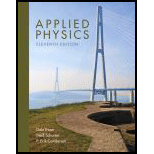
Applied Physics (11th Edition)
11th Edition
ISBN: 9780134159386
Author: Dale Ewen, Neill Schurter, Erik Gundersen
Publisher: PEARSON
expand_more
expand_more
format_list_bulleted
Textbook Question
Chapter 24, Problem 5RP
Convert the mass of one proton (m = 1.67 × 10 –27 kg) to energy.
Expert Solution & Answer
Want to see the full answer?
Check out a sample textbook solution
Students have asked these similar questions
What is the speed of an electron in an accelerator, if its mass is 9.1x10-31 kg and its kinetic energy is 9.2x10-18J?
What is the total energy of a proton moving at a speed of 2.4 × 108 m/s? (proton mass is 1.67 × 10−27 kg and c = 3.00 × 108 m/s)
The chemical energy of gasoline is 46 MJ/kg. If gasoline’s mass could be completely converted into energy, what mass of gasoline would be needed to equal the chemical energy content of 1.0 kg of gasoline?
Chapter 24 Solutions
Applied Physics (11th Edition)
Ch. 24.2 - If the tip of a pencil has a mass of 2.30 g, how...Ch. 24.2 - If a textbook has a mass of 1.30 kg, how much...Ch. 24.2 - How much mass is needed to create 600 J of energy?Ch. 24.2 - How much mass is needed to create 67.0 J of...Ch. 24 - What field or fields of physics intrigued Einstein...Ch. 24 - Which of the following did Albert Einstein not...Ch. 24 - Prob. 3RQCh. 24 - Prob. 4RQCh. 24 - If you are riding a bike at 10.0 m/s and throw a...Ch. 24 - Prob. 6RQ
Ch. 24 - According to Einsteins second postulate, if you...Ch. 24 - What does traveling close to the speed of light do...Ch. 24 - While you are sitting and reading this question,...Ch. 24 - Explain what E = mc2 represents.Ch. 24 - Prob. 11RQCh. 24 - Prob. 12RQCh. 24 - What happens to light and other electromagnetic...Ch. 24 - Explain how the solar eclipse of 1919 proved...Ch. 24 - A train is moving at a speed of 65.0 mi/h. The...Ch. 24 - How fast is the ticket collector in Problem 1...Ch. 24 - The ticket collector in Problem 1 turns around and...Ch. 24 - Convert the mass of one electron (m = 9.10 1031...Ch. 24 - Convert the mass of one proton (m = 1.67 10 27...Ch. 24 - A particular task requires 9 80 J of energy. Using...
Additional Science Textbook Solutions
Find more solutions based on key concepts
Volcanic and other such activity at the mid-Athletic ridge extrudes material to fill the gap between separating...
College Physics
Lakes freeze from top down we all know that ice cubes float in a glass of water. Why? Virtually every substance...
College Physics
Choose the best answer to each of the following. Explain your reasoning. Which objects have the most elliptical...
The Cosmic Perspective Fundamentals (2nd Edition)
The line integral of the magnetic field on a closed path surrounding a wire has the value 8.8 Tm. Find the curr...
Essential University Physics: Volume 2 (3rd Edition)
Is it correct to say that an electric motor is a simple extension of the physics that underlies a galvanometer?
Conceptual Integrated Science
Why do we need to be careful about work done on the system versus work done by the system in calculations?
University Physics Volume 2
Knowledge Booster
Learn more about
Need a deep-dive on the concept behind this application? Look no further. Learn more about this topic, physics and related others by exploring similar questions and additional content below.Similar questions
- It is said that Einstein, in his teenage years, asked the question, What would I see in a mirror if I carried it in my hands and ran at the speed of light? How would you answer this question?arrow_forwardIn fact, the conversion of mass to energy in the Sun is not 100% efficient. As we have seen in the text, the conversion of four hydrogen atoms to one helium atom results in the conversion of about 0.02862 times the mass of a proton to energy. How much energy in joules does one such reaction produce? (See Appendix E for the mass of the hydrogen atom, which, for all practical purposes, is the mass of a proton.)arrow_forwardAn electron has a kinetic energy 5 times greater than its rest energy. Find (a) its total energy and (b) its speed.arrow_forward
- Consider the relativistic form of Newtons second law. Show that when F is parallel to v, F=m(1v2c2)3/2dvdt where m is the mass of an object and v is its speed.arrow_forwardWhat is the relative velocity of two spaceships if one fires a missile at the other at 0.750c and the other observes it to approach at 0.950c?arrow_forwardWhen a missile is shot from one spaceship toward another, it leaves the first at 0.950c and approaches the other at 0.750c. What is the relative velocity of the two ships?arrow_forward
- Give a physical argument showing that it is impossible to accelerate an object of mass m to the speed of light, even with a continuous force acting on it.arrow_forwardHow much mass is required to produce 1.6 x 10^14 J of energy?arrow_forwardAn electron has a rest mass of 9.11×10^(-28) g. What is the energy contained in the electron provided it is accelerated to the speed of light in kJ? Express the answer in 4 significant figures.arrow_forward
- A boat takes 3.00 hourshours to travel 50.0 kmkm down a river, then 6.10 hourshours to return. How fast is the river flowing?arrow_forwardAn unknown particle in an accelerator moving at a speed of 1.50 × 108 m/s has a measured total energy of 3.30 × 10−9 J. What is its mass? (c = 3.00 × 108 m/s)arrow_forward25.) If 1 kilogram of matter could be converted entirely to energy, how much energy would be produced? 9 x 1016 J 11 x 1016 J 12 x 1016 J 10 x 1016 Jarrow_forward
arrow_back_ios
SEE MORE QUESTIONS
arrow_forward_ios
Recommended textbooks for you
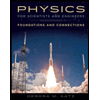 Physics for Scientists and Engineers: Foundations...PhysicsISBN:9781133939146Author:Katz, Debora M.Publisher:Cengage Learning
Physics for Scientists and Engineers: Foundations...PhysicsISBN:9781133939146Author:Katz, Debora M.Publisher:Cengage Learning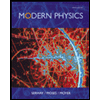 Modern PhysicsPhysicsISBN:9781111794378Author:Raymond A. Serway, Clement J. Moses, Curt A. MoyerPublisher:Cengage Learning
Modern PhysicsPhysicsISBN:9781111794378Author:Raymond A. Serway, Clement J. Moses, Curt A. MoyerPublisher:Cengage Learning Principles of Physics: A Calculus-Based TextPhysicsISBN:9781133104261Author:Raymond A. Serway, John W. JewettPublisher:Cengage Learning
Principles of Physics: A Calculus-Based TextPhysicsISBN:9781133104261Author:Raymond A. Serway, John W. JewettPublisher:Cengage Learning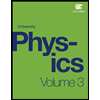 University Physics Volume 3PhysicsISBN:9781938168185Author:William Moebs, Jeff SannyPublisher:OpenStax
University Physics Volume 3PhysicsISBN:9781938168185Author:William Moebs, Jeff SannyPublisher:OpenStax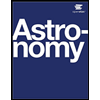 AstronomyPhysicsISBN:9781938168284Author:Andrew Fraknoi; David Morrison; Sidney C. WolffPublisher:OpenStax
AstronomyPhysicsISBN:9781938168284Author:Andrew Fraknoi; David Morrison; Sidney C. WolffPublisher:OpenStax

Physics for Scientists and Engineers: Foundations...
Physics
ISBN:9781133939146
Author:Katz, Debora M.
Publisher:Cengage Learning

Modern Physics
Physics
ISBN:9781111794378
Author:Raymond A. Serway, Clement J. Moses, Curt A. Moyer
Publisher:Cengage Learning

Principles of Physics: A Calculus-Based Text
Physics
ISBN:9781133104261
Author:Raymond A. Serway, John W. Jewett
Publisher:Cengage Learning

University Physics Volume 3
Physics
ISBN:9781938168185
Author:William Moebs, Jeff Sanny
Publisher:OpenStax

Astronomy
Physics
ISBN:9781938168284
Author:Andrew Fraknoi; David Morrison; Sidney C. Wolff
Publisher:OpenStax
Time Dilation - Einstein's Theory Of Relativity Explained!; Author: Science ABC;https://www.youtube.com/watch?v=yuD34tEpRFw;License: Standard YouTube License, CC-BY